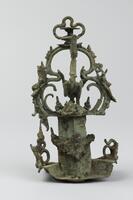49 UMMA Objects
49 UMMA Objects

Chinese (Chinese (culture or style))
Bowl
14th century
Gift of Toshiko Ogita in memory of Tomoo Ogita
1987/1.306
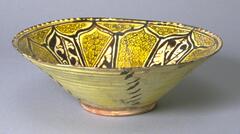
Iranian (Iranian)
Shallow bowl with stylized floral medallion
1000 – 1199
Museum purchase made possible by the Margaret Watson Parker Art Collection Fund
1961/1.183
![<p>This type of bowl was extensively produced throughout the 12th century. The outer wall is decorated with incised and raised deisgn of a two-tiered lotus petal. The glaze was oxidized, producing yellow-green color, but the application of glaze to the entire foot and the use of quartzite spurs indicate that this was produced as a high-quality item.<br />
[<em>Korean Collection, University of Michigan Museum of Art</em> (2014) p.103]</p>
It has a wall gently curving from the mouth toward the bottom before angeling in sharply close to the foot. There is a lotus petal on exterior. The color is brown. <p>This type of bowl was extensively produced throughout the 12th century. The outer wall is decorated with incised and raised deisgn of a two-tiered lotus petal. The glaze was oxidized, producing yellow-green color, but the application of glaze to the entire foot and the use of quartzite spurs indicate that this was produced as a high-quality item.<br />
[<em>Korean Collection, University of Michigan Museum of Art</em> (2014) p.103]</p>
It has a wall gently curving from the mouth toward the bottom before angeling in sharply close to the foot. There is a lotus petal on exterior. The color is brown.](/media/W1siZiIsIjIwMjIvMDUvMjUvMTBnN25oa2prcF9kZWZhdWx0LmpwZyJdLFsicCIsInRodW1iIiwiMjQweDIwMCJdXQ?sha=225012457d334d64)
Korean (Korean (culture or style))
Bowl with carved lotus pattern
12th century
Transfer from the College of Architecture and Design
1972/2.78

Chinese (Chinese (culture or style))
Bowl
1000 – 1132
Gift of Mrs. Caroline I. Plumer for the James Marshall Plumer Collection
1973/2.14
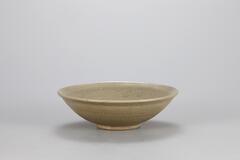
Chinese (Chinese (culture or style))
Bowl
11th century
Gift of Mr. Jennis R. Galloway through the Friends of the Museum of Art
1972/1.154
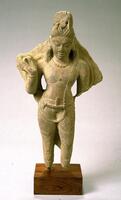
Indian (Indian (South Asian))
Standing figure of Shiva
900 – 1099
Gift of Mark and Iuliana Phillips
1998/1.181
![<p>This bowl is typical of early-Goryeo celadon in terms of shape and pattern. Similar examples have been excavated from sedimentary layers from the Kiln no. 10 at Yongun-ri, Gangjin-gun, Jeollanam-do. The entire inner wall is decorated with chrysanthemum sprays incised in fine lines. Chrysanthemum spray design is commonly found in Goryeo celadon produced between the 10th and the 11th centuries along with the motifs of chrysanthemum, scroll, cloud, parrot, and wave. The design is resemblent to those found in Yue ware, but the clay and glaze were sintered better and the glaze was exquisitely fused to turn into the beautiful color without crackles. Six refractory spurs were used to support the bowl during firing. The bowl was restored after a breakage into two halves.<br />
[<em>Korean Collection, University of Michigan Museum of Art </em>(2014) p.92]</p>
<br />
Stoneware bowl with celadon glaze. The bowl is decorated by an incised line stretching parallel to the rim, bounding a chrysanthemum design below. <p>This bowl is typical of early-Goryeo celadon in terms of shape and pattern. Similar examples have been excavated from sedimentary layers from the Kiln no. 10 at Yongun-ri, Gangjin-gun, Jeollanam-do. The entire inner wall is decorated with chrysanthemum sprays incised in fine lines. Chrysanthemum spray design is commonly found in Goryeo celadon produced between the 10th and the 11th centuries along with the motifs of chrysanthemum, scroll, cloud, parrot, and wave. The design is resemblent to those found in Yue ware, but the clay and glaze were sintered better and the glaze was exquisitely fused to turn into the beautiful color without crackles. Six refractory spurs were used to support the bowl during firing. The bowl was restored after a breakage into two halves.<br />
[<em>Korean Collection, University of Michigan Museum of Art </em>(2014) p.92]</p>
<br />
Stoneware bowl with celadon glaze. The bowl is decorated by an incised line stretching parallel to the rim, bounding a chrysanthemum design below.](/media/W1siZiIsIjIwMjIvMDkvMjQvM2djdWZxdmhieV9kZWZhdWx0LmpwZyJdLFsicCIsInRodW1iIiwiMjQweDIwMCJdXQ?sha=8591e65ef730993a)
Korean (Korean (culture or style))
Bowl with Chrysanthemum Design
900 – 1099
Gift of Bruce and Inta Hasenkamp and Museum purchase made possible by Elder and Mrs. Sang-Yong Nam
2004/1.220
![<p>This bowl has a narrow foot and a ared mouth. is type of bowl was produced in large quantities from the 11th century to the 12th century. Its inner wall has mold-impressed peony sprays. The entire body of the bowl is glazed, including the inside of the foot, but the glaze on its rim of the foot was wiped away, on which refractory spurs were adhered to for ring. Parts of the inner surface show ne crackles, while the inner bottom was stained with greenish-brown iron spots. One part of the rim was damaged and subsequently repaired. Glaze applied to the outer surface has partially owed downwards, resulting in an uneven surface, but the glaze and clay are quite well fused and sintered.<br />
[<em>Korean Collection, University of Michigan Museum of Art</em> (2014) p.93]</p>
<br />
The celadon bowl has straight-lined sides. The surface is evenly coated with a dark bluish green glaze. The celadon bowl rests on a rather tall foot, which was hollowed out from the bottom. The designs are present only on the inside <p>This bowl has a narrow foot and a ared mouth. is type of bowl was produced in large quantities from the 11th century to the 12th century. Its inner wall has mold-impressed peony sprays. The entire body of the bowl is glazed, including the inside of the foot, but the glaze on its rim of the foot was wiped away, on which refractory spurs were adhered to for ring. Parts of the inner surface show ne crackles, while the inner bottom was stained with greenish-brown iron spots. One part of the rim was damaged and subsequently repaired. Glaze applied to the outer surface has partially owed downwards, resulting in an uneven surface, but the glaze and clay are quite well fused and sintered.<br />
[<em>Korean Collection, University of Michigan Museum of Art</em> (2014) p.93]</p>
<br />
The celadon bowl has straight-lined sides. The surface is evenly coated with a dark bluish green glaze. The celadon bowl rests on a rather tall foot, which was hollowed out from the bottom. The designs are present only on the inside](/media/W1siZiIsIjIwMjIvMDkvMjQvOWpqdXU4d2plel9kZWZhdWx0LmpwZyJdLFsicCIsInRodW1iIiwiMjQweDIwMCJdXQ?sha=d6b4e1202cb44ca4)
Korean (Korean (culture or style))
Conical bowl with molded floral design
12th century
Gift of Bruce and Inta Hasenkamp and Museum purchase made possible by Elder and Mrs. Sang-Yong Nam
2004/1.222
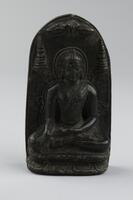
Indian (Indian (South Asian))
Buddha, seated under a canopy of 3 leaves on a double lotus dais in the padmasana pose, in bhumisparsa mudra, flanked by two stupas
11th century
Museum purchase made possible by the Margaret Watson Parker Art Collection Fund
1983/1.396
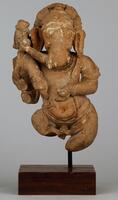
Indian (Indian (South Asian))
Dancing Ganesha
1000 – 1199
Gift of Mark Phillips and Iuliana Phillips
2007/2.45
Loading…

